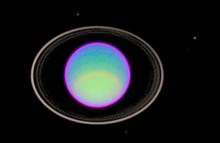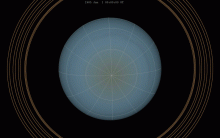Listen to today's episode of StarDate on the web the same day it airs in high-quality streaming audio without any extra ads or announcements. Choose a $8 one-month pass, or listen every day for a year for just $30.
You are here
Uranus at Opposition II
The planet Uranus is stepping up its game right now. It’s at a point known as opposition — it lines up opposite the Sun. It rises around sunset and is in the sky all night. It’s also closest to us at opposition, so it’s brightest for the year.
Unfortunately, it’s quite close to the Moon. This evening, it’s to the left of the full Moon — known as the Hunter’s Moon. The moonlight makes it tough to spot the faint planet, even with binoculars. It’ll be in better view in a few nights, as the Moon moves away from it.
Uranus hosts a couple of dozen moons of its own. The largest is Titania, which is named for the queen of the fairies in “A Midsummer Night’s Dream.” It’s less than half the diameter of our moon. But it’s about the same distance from Uranus as the Moon is from Earth. And like the Moon, the same hemisphere always faces its planet.
Titania probably has a rocky core, surrounded by layers of rock and ice. Some of its most interesting surface features are tall cliffs and deep canyons. They might have formed long ago, when a layer of liquid water below the surface froze. The freezing water expanded, cracking the layers of ice and rock above it.
Some of the water may have oozed all the way to the surface, repaving the moon. That obliterated any existing impact craters. So today, the surface of Titania is pockmarked by fewer craters than Uranus’s other major moons. That creates a younger face for this intriguing moon.
Script by Damond Benningfield






